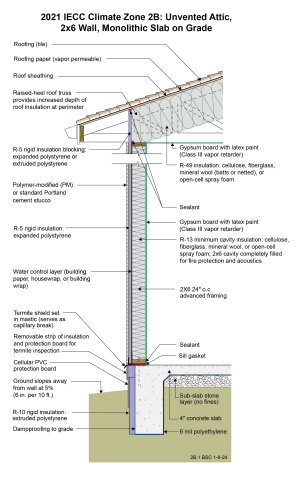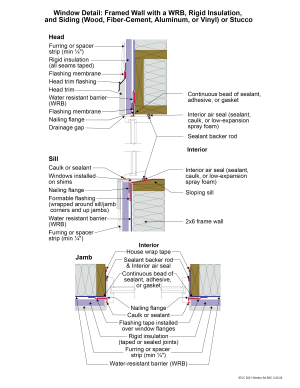
2021 IECC Climate Zone 2B Building Assembly: Unvented Attic, 2x6 Wall, Monolithic Slab on Grade
2021 IECC Climate Zone 2B: Unvented Attic, 2x6 Wall, Monolithic Slab on Grade
Notes
Drawing 2B.1: IECC CZ 2B: Unvented Attic, 2x6 Wall, Monolithic Slab on Grade
- The insulation in this unvented attic is located on the underside of the roof sheathing. With tile roofing and vapor-permeable roofing paper, no venting or vapor diffusion ports are required for this roof assembly. If the roofing material were shingles, vapor diffusion ports would be needed. Unvented attics are more resistant to wind uplift under hurricane conditions.
- If a raised-heel roof truss is used to allow R-38 attic insulation over the full width of the exterior wall, then R-38 can be used throughout the attic rather than R-49. See Section R402.2.1 of the 2021 IECC.
- The purpose of the rigid foam insulation on the exterior of the wall is to resist inward vapor drive from the absorptive stucco cladding. This wall has no structural sheathing. Instead, it has metal bracing (not shown) for racking resistance.
- The water control layer in the wall assembly is installed behind the rigid insulation. Drainage occurs between the water control layer and the back side of the rigid insulation.
- The wall is framed with 2x6 24” o.c. advanced framing as it uses less board footage (volume of wood framing) than standard 2x4 16” o.c. framing and therefore is less expensive in material cost. It is also less expensive in labor (25% fewer framing members) and is faster to assemble. Although the code allows for 2x4 framing and lower R-value cavity insulation, the use of advanced framing and the associated cost savings more than offset the increase in the cost of cavity insulation (this of course depends on relative price fluctuations in labor and materials).
- Although the minimum R-value of the insulation in this wall is R-13 per IECC, fire code may require the entire cavity to be filled, likely resulting in a higher R-value for a 2x6 wall.
- A class III vapor retarder (latex paint) is used on the interior surface of the walls and ceiling instead of a vapor barrier. This allows drying to the interior. Avoid vinyl wallpaper and oil-based paint or coatings in Climate Zone 2. These wall coverings are vapor impermeable and increase the risk of condensation within the wall.
- The rigid insulation on the exterior of the monolithic slab has a removable strip to facilitate termite inspection. The code does not call for rigid insulation at this location in Climate Zone 2 – it is recommended for comfort reasons.
- The entire monolithic concrete slab should have a polyethylene vapor barrier wrapping the underside of the slab and footing to control capillary uptake. The polyethylene should extend upward from the bottom of the footing to grade on the exterior.
2021 IECC Window Detail: Framed Wall with a WRB, Rigid Insulation, and Siding (Wood, Fiber Cement, Aluminum or Vinyl) or Stucco
Notes
Window Detail 6A - Framed Wall with a WRB, Rigid Insulation, and Siding (Wood, Fiber Cement, Aluminum or Vinyl) or Stucco
- Note: Always follow the window manufacturer’s installation guidance. Not following manufacturer guidance may void the warranty.
- This is a “drained wall”. Drainage occurs outside of the water resistive barrier (WRB). A drainage gap between the WRB and the rigid insulation is created by installing “cap nails” which act as a spacer.
- Drainage also occurs between the siding and the exterior face of the rigid insulation. A drainage gap is provided by furring installed vertically over the exterior face of the rigid insulation at stud locations.
- The window openings are drained to the exterior face of the WRB.
- The rough opening at the windowsill is sloped and flashed to the WRB with a formable flashing.
- The upper portion of the head trim flashing goes under the furring and is taped directly to the rigid foam with flashing tape. The furring is “cut through” by the head trim flashing, so that the furring below the flashing (behind the head trim) is separate from the furring above the flashing (behind the siding). During construction the head trim is installed first on short pieces of furring. It is flashed directly to the rigid foam as described above. The rest of the furring is installed with the siding.
- Note the gap between the head trim and the top of the window assembly frame. This gap allows water to drain and allows the bottom of the trim to dry out more easily. If installed without this gap, capillary action can draw water into the tight space between the head trim and the window assembly frame. Note also the gap between the siding and the head trim flashing, which serves the same purposes.
- Consider installing rigid head flashing (rigid head flashing is not shown in the schematic). Rigid head flashing is similar to the head trim flashing shown in the schematic, but it goes over the top of the window frame instead of over the head trim. This is required by some manufacturers. It should be installed against the head nailing flange and over the top of the window frame. The vertical and horizontal portion of the flashing should be sealed directly to the window frame and flange with sealant. The red flashing membrane strip shown overlapping the head nailing flange in the schematic would now overlap the rigid head flashing. Use rigid head flashing with a drip edge to guide water away from the window assembly.
- Backer rod for the interior air sealant should be installed after the window is installed, leveled, and shimmed. Use the correct size backer rod.

